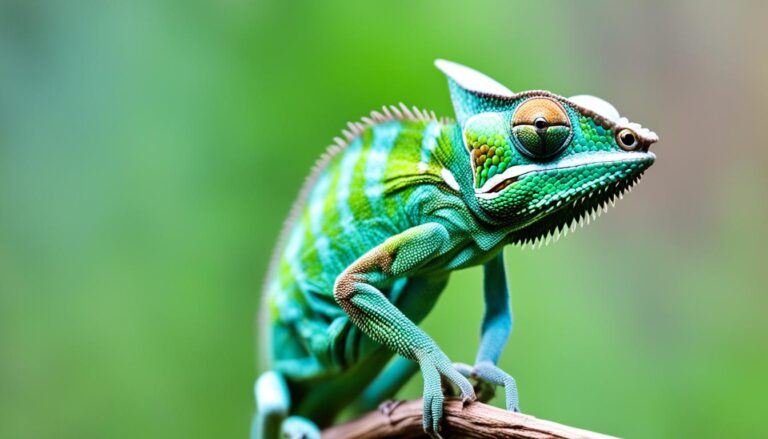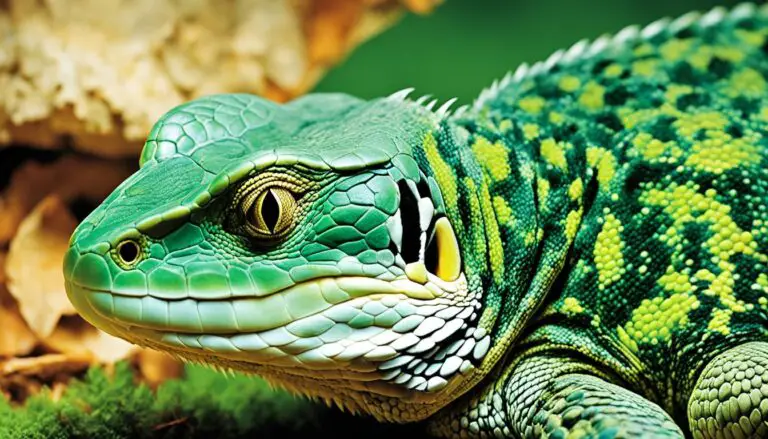Exotic Pet Behavior Problems: Tips & Solutions
Exotic pets, like any other pet, can experience behavior problems that can be challenging for their owners. While dogs and cats are more commonly associated with behavior issues, exotic animals also have specific behavioral needs and challenges. It’s important to understand these unique behaviors and learn how to address them effectively in order to have a well-behaved and happy exotic pet.
Key Takeaways:
- Exotic animals can have behavior problems that require attention and management.
- Feather plucking and aggression are common behavior problems in exotic birds.
- Territorial aggression is a concern for male green iguanas and other reptiles.
- Maladaptation, where reptiles attempt to escape their enclosures, is a behavior issue to address.
- Rabbits may exhibit destructive behaviors like chewing and digging, which can be managed through appropriate outlets.
Common Behavior Problems in Exotic Birds
Exotic birds make fascinating and beautiful pets, but like any animal, they can experience behavior problems that require attention and management. Two common behavior problems seen in exotic birds are feather plucking and aggression.
Feather Plucking
Feather plucking is a behavior where birds excessively groom and pluck their feathers, leading to bald patches on their bodies. This behavior can be distressing for both the bird and its owner. Feather plucking often stems from stress, boredom, or anxiety.
“Feather plucking is often associated with stress, boredom, or anxiety and can be managed through behavioral/environmental modification and mental stimulation.”
To address feather plucking, it’s important to identify and address the underlying cause. Providing a stimulating and enriching environment for the bird can help alleviate boredom and reduce stress. This can include offering a variety of toys, providing regular mental stimulation through puzzles and foraging activities, and maintaining a consistent routine. Additionally, addressing any potential sources of anxiety or stress, such as noise or environmental changes, can also help manage feather plucking behaviors.
Aggression
Aggressive behaviors in exotic birds can manifest as biting, lunging, or territorial displays. Aggression can be dangerous and should be addressed promptly to ensure the safety of both the bird and its owners.
“Aggression, which manifests as biting and lunging, can be addressed through behavioral modification and positive reinforcement techniques like target training.”
Behavioral modification techniques, such as target training and positive reinforcement, can help address aggression in exotic birds. Target training involves teaching the bird to touch a particular target, which serves as a distraction and helps redirect their behavior. Positive reinforcement, such as rewarding the bird with treats or praises for desirable behaviors, can help reinforce positive interactions and reduce aggressive tendencies.
Creating a calm and predictable environment for the bird, establishing clear boundaries, and avoiding triggers for aggressive behavior are also important strategies for managing aggression in exotic birds.
A Stimulating Environment and Routine
Providing a stimulating environment and establishing a predictable routine are key factors in managing behavior problems in exotic birds. Keeping the bird engaged with a variety of toys, perches, and mental stimulation activities can help prevent boredom and problematic behaviors. Additionally, establishing a routine for feeding, social interaction, and exercise can provide a sense of security and stability for the bird, helping them feel calm and happy.
By understanding, addressing, and managing these behavior problems, exotic bird owners can create a harmonious and enriching environment for their feathered friends.

Dealing with Aggression in Reptiles
Aggression is a common behavior issue in reptiles, especially in male green iguanas. Understanding and addressing aggression in reptiles is crucial to ensure the safety of both the owner and the reptile. Here are some strategies to manage and prevent aggressive behaviors:
- Environmental Modification: Providing a larger enclosure can help reduce territorial behavior in reptiles. By giving them enough space to establish their territory, you can minimize aggressive tendencies. Additionally, limiting contact with other iguanas can prevent confrontations that may lead to aggression.
- Medication: In severe cases of aggression, medication such as diazepam may be considered. It can help calm the reptile and reduce aggressive behaviors. However, medication should only be used under the guidance of a veterinarian or reptile behavior specialist.
- Castration: Castration of juvenile male iguanas can help prevent the development of aggressive behaviors. This surgical procedure reduces the production of testosterone, which is responsible for triggering aggressive tendencies in male reptiles.
By implementing these strategies, reptile owners can effectively manage aggression in their pets and create a safer and more harmonious environment for both the reptile and themselves.

Real-Life Example:
“My green iguana, Spike, started showing signs of aggression towards other iguanas in our reptile enclosure. After consulting with a reptile behaviorist, we decided to provide him with a larger enclosure and separate him from other iguanas. This significantly reduced his territorial behavior and aggression. We also ensured he received plenty of mental stimulation through enrichment activities. Spike is now a much calmer and happier reptile.”
| Signs of Aggression | Management Strategies |
|---|---|
| Biting and tail whipping | Environmental modification |
| Increased body posturing | Medication (under veterinary supervision) |
| Threatening displays (e.g., head bobbing) | Castration of juvenile male iguanas |
Managing Maladaptation in Reptiles
Maladaptation is a behavior problem observed in reptiles where they repeatedly attempt to escape their enclosure. This behavior is common in certain species like reticulated pythons and water dragons. Proper enclosure design, including providing adequate space, hiding spots, and environmental enrichment, can help prevent maladaptation. Owners should create an environment that meets the natural needs of the reptile to reduce this behavior.
Reptiles have unique environmental requirements that must be met to ensure their well-being. Providing a suitable enclosure that mimics their natural habitat is crucial in preventing maladaptation. For example, reticulated pythons, native to Southeast Asia, require a large enclosure with ample climbing opportunities to satisfy their arboreal nature. Water dragons, found in Southeast Asia and Australia, need a spacious enclosure with a water feature to accommodate their semi-aquatic habits.
One effective strategy is to provide hiding spots within the enclosure. Reptiles often seek shelter when they feel threatened or stressed, and access to hiding spots can help alleviate their anxiety. These hiding spots can include artificial caves, logs, or stacked rocks.
Environmental enrichment is another important aspect of managing maladaptation in reptiles. By offering a variety of stimuli, such as branches, logs, and live plants, owners can create a more engaging and stimulating environment for their reptile companions. This allows them to engage in natural behaviors like climbing and exploring, reducing the likelihood of escape attempts.
Additionally, owners should ensure that the enclosure is escape-proof. Reptiles are skilled escape artists and can find even the smallest openings. Regularly inspecting the enclosure for any potential escape routes, such as loose locks or gaps in the enclosure walls, is essential to prevent maladaptation.
Key Tips for Managing Maladaptation in Reptiles:
- Provide a spacious enclosure that meets the natural needs of the reptile
- Incorporate hiding spots within the enclosure
- Offer environmental enrichment through the addition of branches, logs, and live plants
- Regularly inspect the enclosure for any potential escape routes
By implementing these strategies, reptile owners can effectively manage maladaptation and create a safe and enriching environment for their scaly friends.

Addressing Destructive Behavior in Rabbits
Destructive behaviors such as chewing and digging are common in rabbits. These natural behaviors can be frustrating for owners, but with the right approach, they can be redirected and managed effectively.
To address destructive behaviors in rabbits, it is important to provide appropriate outlets for these behaviors. One effective strategy is to provide a digging box filled with safe materials like shredded paper or hay. This allows rabbits to indulge in their natural digging instinct while protecting your furniture and belongings.
In addition to a digging box, mentally stimulating toys can also help redirect destructive behavior. Interactive toys, such as treat puzzles or foraging toys, engage rabbits’ natural instincts and provide them with mental enrichment. This helps keep them entertained and prevents them from engaging in destructive habits.
Establishing a predictable routine is another important strategy in managing destructive behavior. Rabbits thrive on consistency and feel more secure when they know what to expect. By providing a structured daily routine for feeding, playtime, and exercise, you can reduce stress and minimize destructive behaviors.
Regular exercise is essential for rabbits to release their energy and prevent boredom. Bunny-proofing a safe exercise space, such as a designated play area or using pet enclosures, allow rabbits to stretch their legs and engage in natural behaviors like hopping and exploring. This helps burn off excess energy and reduces the likelihood of destructive behavior.
Remember, addressing destructive behavior in rabbits requires patience and consistency. Keep in mind that rabbits have natural instincts and behaviors that can’t be entirely eliminated. However, by providing appropriate outlets, mental stimulation, a consistent routine, and ample exercise, you can effectively manage and minimize destructive behaviors in rabbits.
Examples of Rabbit-Safe Toys
| Toy Type | Description |
|---|---|
| Treat Puzzles | Toys that require the rabbit to solve a puzzle or manipulate objects to access treats or food. |
| Foraging Toys | Toys that hide treats or food within compartments or materials, encouraging rabbits to forage and explore. |
| Cardboard Boxes | Boxes filled with hay or shredded paper that rabbits can chew and burrow in. |
| Chew Toys | Safe, rabbit-specific chew toys made from natural materials like wood or untreated willow. |
| Tunnels | Tubes or tunnels that provide a space for rabbits to run through and explore. |
Species-Specific Behaviors and Training Needs
When it comes to exotic pets, understanding their species-specific behaviors and training needs is crucial for their well-being. Each exotic pet has unique characteristics and preferences, and as an owner, it’s important to research and understand these traits to provide the best care and training.
One key aspect of training exotic pets is communication cues. These cues vary among different species and can include vocalizations, body language, and specific behaviors. By understanding and responding to these cues, owners can effectively communicate with their pets and address any behavior issues that may arise. Positive reinforcement training techniques are particularly effective in encouraging desired behaviors and discouraging unwanted ones.
Enrichment activities play a vital role in meeting the mental and physical stimulation needs of exotic pets. These activities can include puzzle toys, foraging opportunities, and environmental enrichment that mimics their natural habitat. By engaging in these activities, exotic pets can lead fulfilling lives and exhibit fewer behavior problems.
Proper handling techniques are also essential for the well-being of exotic pets. Some species may require specialized handling due to their physical characteristics or temperament. Getting familiar with safe handling practices can help prevent stress or injury to both the pet and the owner.
Socialization is another critical aspect in addressing exotic pet behavior issues. Exposing exotic pets to different environments, people, and animals from an early age can reduce fear and aggression. Gradual and positive socialization experiences can help ensure that exotic pets are comfortable in various situations, making them better-adjusted companions.

It’s worth noting that while there are general guidelines for training and addressing behavior issues in exotic pets, each individual animal may have its own unique needs and challenges. Consulting with a veterinarian or animal behaviorist who specializes in exotic pets can provide valuable guidance and tailored strategies for addressing behavior issues specific to a particular species.
| Species | Unique Behaviors | Training Needs |
|---|---|---|
| Parrots | Talking, mimicry, feather plucking | Vocalization training, environmental enrichment |
| Iguanas | Aggression, basking behavior | Territorial management, temperature control |
| Rabbits | Digging, chewing, thumping | Enrichment activities, redirecting behavior |
| Turtles | Basking, shell hiding, swimming | Proper habitat setup, diet management |
Understanding species-specific behaviors and training needs is key to building a strong bond with your exotic pet and addressing behavior issues effectively. By providing the appropriate training, enrichment, handling, and socialization experiences, you can ensure that your exotic pet thrives in your care.
Professional Guidance and Training Classes
When it comes to addressing behavior problems in exotic pets, seeking professional guidance is essential. A veterinarian or animal behaviorist who specializes in exotic pet behavior can provide invaluable insight, personalized solutions, and address the underlying causes of these problems. Their expertise and experience in working with exotic pets can make a significant difference in managing behavior issues effectively.
Additionally, attending training classes specifically designed for exotic pets can be highly beneficial. These classes offer owners the opportunity to learn helpful techniques and receive guidance from experienced instructors who understand the unique challenges of training and managing exotic pets. With their expertise, you can gain valuable insights about exotic pet training tips and behavioral guidance tailored to your pet’s specific needs.
Benefits of Professional Guidance and Training Classes
There are several advantages to seeking professional guidance and attending training classes for your exotic pet:
- Expertise: Professionals specializing in exotic pet behavior have the knowledge and experience to address a wide range of behavior problems effectively.
- Personalized Solutions: Through an in-depth understanding of exotic pet behavior, professionals can provide customized solutions that suit your pet’s unique needs.
- Understanding Underlying Causes: Professionals can identify and address the underlying causes of behavior problems, helping to resolve them at their root.
- Effective Training Techniques: Trainers in specialized exotic pet classes can teach you proven training techniques that work specifically for exotic species.
- Supportive Environment: Training classes provide a supportive community of fellow exotic pet owners, allowing you to share experiences and seek guidance from others facing similar challenges.
Overall, professional guidance and training classes are invaluable resources for owners of exotic pets. They can provide you with the knowledge, skills, and support needed to address behavior problems and ensure the well-being of your beloved exotic companion.
| Benefits of Professional Guidance and Training Classes |
|---|
| Expertise |
| Personalized Solutions |
| Understanding Underlying Causes |
| Effective Training Techniques |
| Supportive Environment |
By seeking professional guidance and attending training classes, you can gain the necessary skills and knowledge to address behavior problems in your exotic pet. These resources can provide you with valuable exotic pet training tips and behavioral guidance, allowing you to enhance your pet’s well-being and strengthen your bond.
Importance of Enrichment and Socialization
Enrichment activities and socialization play a vital role in the well-being and behavior management of exotic pets. By providing mental and physical stimulation, owners can prevent boredom and destructive behaviors in their beloved companions. Additionally, socializing exotic pets with humans and other animals can help reduce fear and improve their overall behavior.
One effective way to provide enrichment for exotic pets is through the use of toys, puzzles, and environmental enrichment. These activities engage their natural instincts and keep them mentally and physically active. For example, providing puzzle feeders or treat-dispensing toys can encourage problem-solving and provide entertainment for both the pet and the owner.
“Enrichment activities and socialization are essential for the overall well-being of exotic pets.”
Furthermore, socialization is crucial for exotic pets to develop positive relationships and adapt to different environments. Early socialization is particularly important to help animals become comfortable with various people, animals, and situations. By gradually exposing them to new experiences in a controlled and positive manner, owners can prevent fear-based behaviors and help their pets become well-adjusted individuals.
In the case of introducing exotic pets to other animals, it’s crucial to take gradual and supervised steps to ensure the safety and well-being of all animals involved. Slowly acclimating them to other pets and using positive reinforcement can help build positive associations and reduce any potential anxiety or aggression.
Benefits of Enrichment and Socialization for Exotic Pets:
- Prevents boredom and destructive behaviors
- Provides mental and physical stimulation
- Encourages problem-solving and curiosity
- Reduces fear and anxiety
- Promotes positive interactions with humans and other animals
- Improves overall behavior and well-being
| Enrichment Activities | Socialization Tips |
|---|---|
| Provide puzzle feeders or treat-dispensing toys | Gradually introduce exotic pets to new people, animals, and environments |
| Create an engaging and stimulating environment with climbing structures or hiding spots | Use positive reinforcement techniques to reward desired behaviors during socialization |
| Rotate toys and environmental enrichment regularly to maintain interest | Provide supervised interactions with other calm and well-socialized animals |
| Offer opportunities for foraging and exploring | Seek guidance from a professional behaviorist or trainer for tailored socialization plans |
| Engage in interactive play sessions with the exotic pet | Expose pets to different sounds, sights, and experiences to desensitize them |
Conclusion
Understanding and addressing behavior problems in exotic pets is crucial for providing them with a happy and balanced life. Exotic pets, like any other pet, can experience behavior problems that require specific attention and guidance. By recognizing the unique behavioral needs of exotic pets, owners can prevent and manage common behavior problems effectively.
Seeking professional guidance from a veterinarian or animal behaviorist who specializes in exotic pet behavior is highly recommended. These experts can provide personalized solutions and address the underlying causes of behavior issues, offering valuable guidance for resolving exotic pet behavior issues.
Enrichment activities and proper training techniques play an essential role in managing exotic pet behavior. Providing mental and physical stimulation through toys, puzzles, and environmental enrichment can prevent boredom and destructive behaviors. Adopting positive reinforcement methods and participating in training classes specifically designed for exotic pets can ensure effective behavior management.
With the right approach, exotic pets can be well-behaved and cherished companions. Resolving exotic pet behavior issues requires patience, understanding, and commitment from their owners. By addressing their specific behavioral needs and seeking professional guidance, owners can create a harmonious environment for their exotic pets, ensuring a happy and fulfilling life for both the pets and their owners.
FAQ
What are some common behavior problems in exotic birds?
How can aggression in reptiles be managed?
What is maladaptation in reptiles?
How can destructive behavior in rabbits be addressed?
What are some species-specific behaviors and training needs of exotic pets?
Should I seek professional guidance for managing exotic pet behavior?
How important is enrichment and socialization for exotic pets?
What should I do to address behavior problems in exotic pets?
Source Links
- https://blog.vettechprep.com/top-5-behavioral-issues-in-exotic-animal-patients
- https://vetbooks.ir/behavior-of-exotic-pets/
- https://indianpetjournal.com/exotic-pets/exotic-pet-behavior-and-training-what-you-need-to-know/
Peter Stones is the founder of Exotic Pets Place, the leading online resource for exotic pet care information.
With over 10 years of hands-on exotic pet ownership experience, he is deeply passionate about sharing his expertise to help others properly care for their unusual pets.
When he's not writing extensively researched articles or connecting with fellow exotic pet enthusiasts worldwide, you can find Peter at home tending to his own beloved menagerie of exotic animals.







